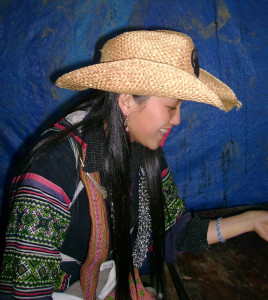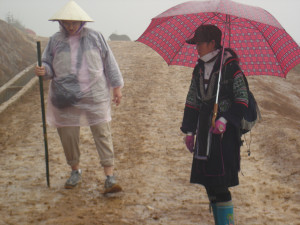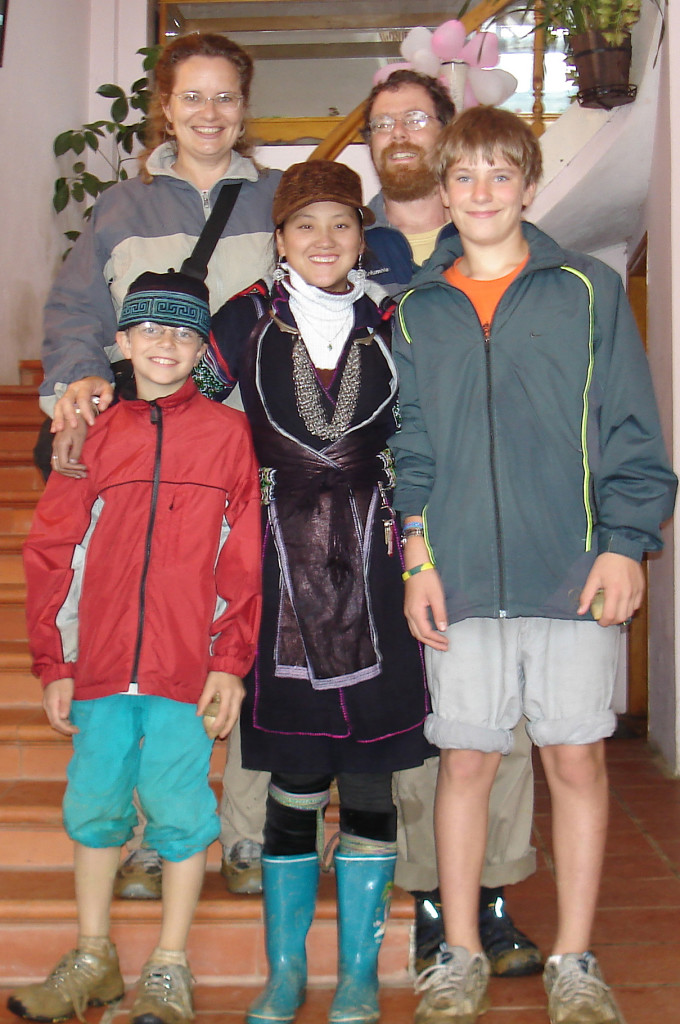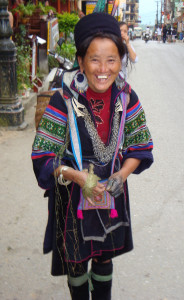Sho: Our Spirited Black Hmong Guide, Friend, and Confidante
Our family was most fortunate on our first trip to Vietnam in 2005 to be teamed up through a guesthouse with Sho Lythi as our guide for our first trek. It had been pouring rain for days, and the trails through the rugged steep hills around Sapa in Lao Cai Province were like pudding – thick and slippery. We considered canceling the day-long walk due to the weather, but Sho quickly arranged a batch of 50-cent disposable plastic rain jackets and bamboo walking sticks, and, with a smile larger than her umbrella, cheered us on our way out into the foggy wet.
Starting on Sapa’s ridge-top location, the route for the first half hour was almost straight down – hilltribe people don’t seem to believe in switch-backs! The kids traveled as though they had skis on their feet, slipping and sliding, using the bamboo pole as a balance, and hooted and hollered as they disappeared over the the lip of the hill. Maren and I, being both heavier and more fragile, carefully chose our steps. Sho, walking patiently with us, chatted cheerily and seemed to almost dance her 80 pound frame down the slope. We arrived at the bottom of the hill at her home, where we dried off, scraped the largest clumps of muck off our shoes, and were introduced to Sho’s parents and many sisters.
From the outside, Sho’s family’s house looks a bit ramshackle, with boards and shingles nailed at odd angles. Pigs, water buffalo, ducks and dogs amble on the front “yard” at the edge of the harvested rice fields. Inside, the floors are dirt; large baskets (triple-walled for rodent protection), both on the floor and up in the wood-planked loft, hold clothing and other textiles, as well as bags of processed rice and corn. Corn also hangs from the ceiling, drying in the smoky, wood-warmed cottage. On the one piece of wooden furniture, a large dresser, sits the color TV; the satellite dish is out back. Sho’s and her mom’s cell phones seem to ring every couple of minutes. An electric iron sits on the ironing board. The house has a single fluorescent light-bulb to illuminate everyone’s sewing and dyeing efforts.
It was dyeing season, and a huge vat of liquid indigo stewed on its own off of the main room. Sho proceeded to educate us all about how her ethnic group, the Black Hmong, dye, weave and sew their own outfits. Every woman makes a new outfit for each family member every year to be first worn on New Year’s, and the old clothing, now faded from wear, is dismantled and made into blankets and other necessities. Dad made tea to share on a second small hearth to help us stave off the damp chill.
Beyond her family’s home, Sho has led us on multiple home-stay treks in Lao Cai Province, and she has helped us acquire some of our treasures at the colorful weekend markets in Bac Ha, Long Phinn and Sapa. Once, quite by accident, we ran into her in Hanoi where she was investing in some English writing classes for a few months. She has a wonderful radiating energy that makes her fun to be with.
Sho, age 18 when we met, is fluent in English, Vietnamese, and Hmong, and boasts a spattering of French and German. She learned English on her own from the western visitors who often hire her as a guide. She is chatty, eager to learn about the world, and obviously very intelligent. When she is in her home province, she dresses in traditional Black Hmong clothing – indigo-dyed knee-length jacket with dyed leggings. Her outfit has bright green embroidered bands around her upper arms and on her collar. Like most Hmong women, she adorns herself with several large necklaces and earrings. When we have met her elsewhere, in Hanoi or in Bac Ha, she wears a western t-shirt, blue jeans, tennis shoes, and her trademark cowboy hat (and we did bring her a true Stetson this last summer). Did I mention she is knock-out beautiful and cute as can be? Ari can barely keep his eyeballs in his head when she’s around! The unique lilt in her accent only adds to her charm.
Sho’s family has also become friends. Sho’s mother, at out first meeting, pulled Maren out of a mucky rice patty with a strong arm and a huge smile. She also taught Maren how to turn twists of hemp into strong continuous rope. Sho’s sister’s husband makes traditional metal Hmong jewelry, and Sho’s sisters all sew handbags and other textiles from their year-old clothing (which we in turn have available at Above the Fray).
In addition to her knowledge about dyeing and weaving, her delicious cooking when we have trekked, and her chatty knowledge about the cultures of the area, Sho is also, we discovered, a shrewd shopper. She has helped us bargain for better deals (where her Vietnamese and Hmong language skills come in handy), and she has a great eye for color, quality, and authenticity. She is eager to learn about western culture and tastes, and her efforts to understand what Above the Fray is looking for spurs both her curiosity and her acumen at assisting us.
What we also love about Sho is her willingness to tell us her opinion. So often the guides and translators we hire want to tell us only what they believe we want to hear. Sho, on the other hand, will openly comment on what she thinks, likes, and dislikes. She maintains a calm and overt confidence that both reveals who she is as a person and facilitates our goal of finding the best hilltribe art in Lao Cai Province. Once, in a small shop that had a collection of used Hmong knives, Sho unhesitatingly picked up each knife and whacked them repeatedly against a hard bamboo stick. After castigating the owner for having some knives with softer, and now slightly blemished, metals, she demanded he only show us the better-quality metal knives – the “real Hmong knives” – and then proceeded to negotiate a better price for the better quality items. Sho has no pretense; she lets people know exactly what she thinks.
Sho has become a trusted friend, someone we can count on to follow through and give us honest opinion and perspective. She knows her culture well, and unhesitatingly wants us to represent the very best of her people.





